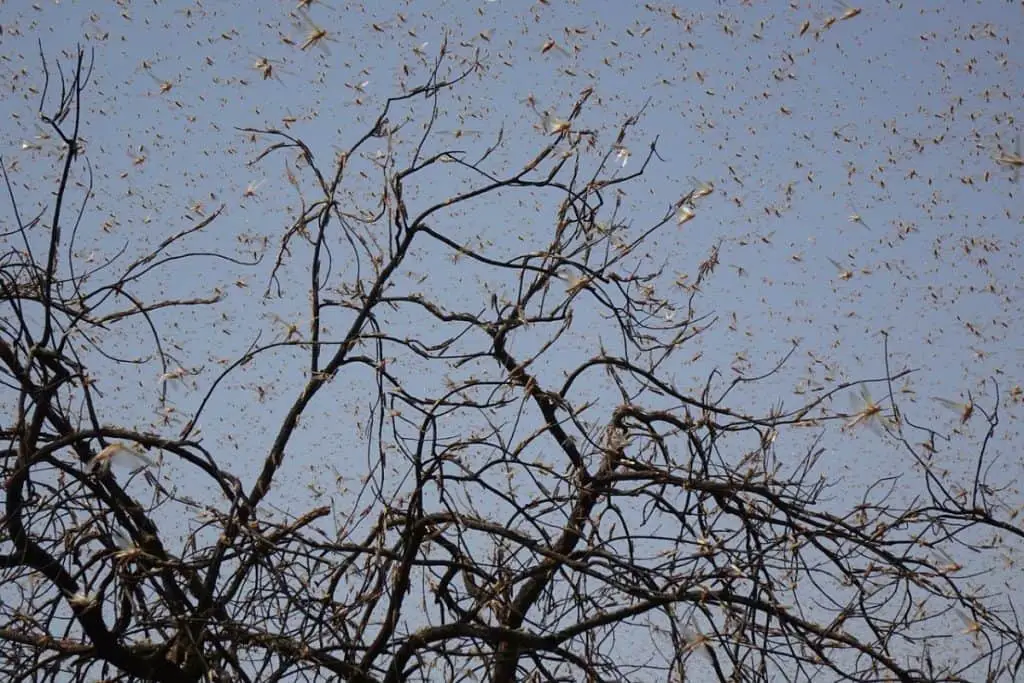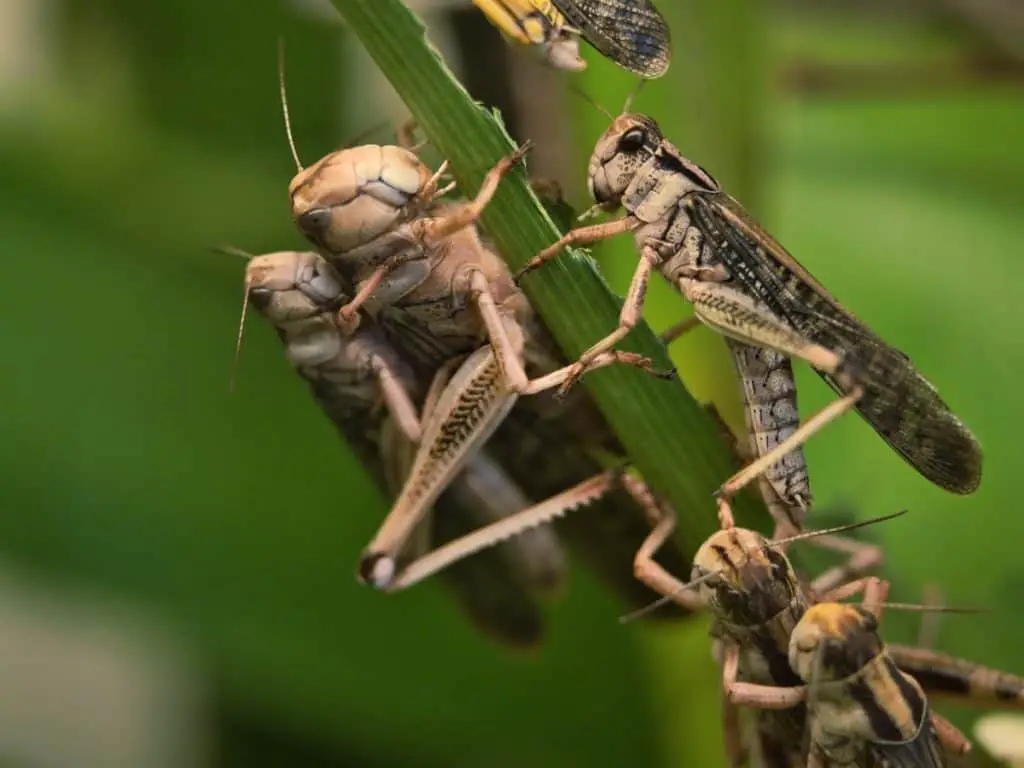Locusts and grasshoppers are generally solitary insects, but when millions of them get together, they can cause untold devastation.
Desert locusts can take on two different forms. They are usually solitary but can turn into a yellow, orange, and black form that swarms together to seek large amounts of food. These smaller swarms join up with others to create extremely large plagues of millions of insects.
With some of the largest swarms recorded recently, it is time to find out why locusts swarm.

Grasshoppers become locusts
Locusts are short-horned grasshoppers that live in two different forms: solitary and gregarious. These two phases are distinct, differing in colour, behaviour, physiology, and ecology.
While solitary, grasshoppers are not much of a problem to crops. An individual eats about 2 grams of food per day. However, they start to flock together when gregarious, and swarms of thousands of insects soon form.
This change in phases is caused by serotonin, hormones, and pheromones and adapts to predators. Locusts are highly camouflaged because they live in small populations. However, if the weather conditions are right, they suddenly form huge swarms, and predation risk decreases.
The change to yellow, orange, and black signifies that they are no longer scared of the risk of predators because of their large swarms.
There are many ways that caterpillars defend themselves. Find out some of them here
How swarms form
Locusts and grasshoppers are generally solitary animals, but with the onset of heavy rains, the behaviour of the locust’s changes. As the ground gives way to new vegetation, the bare ground gives way to grass and herbs. The locusts take advantage of the fresh food and can eat up to their body weight daily. Females can be seen lying in the ground, and the larvae, some of which have been in the ground for up to 20 years, start to emerge. Encounters between locusts are more common, and soon the population builds up.
Locusts move from their usual solitary lives to seeking each other out. The larva grows quickly, with growth that usually takes four weeks now happening in much less time. The young are called hoppers as they cannot fly yet, and they start to develop stripes of orange, yellow, and black.
As the rains continue, more young nymphs can be seen feeding across the ground, eating everything in their path. Hoppers moult, and after their fifth moult, they join the flying adults.
During the day, when it is too hot for continuous movement, they sit on the upper branches of trees and bushes where it is cooler. Large swarms will start to feed on all vegetation in their path once the temperature has cooled down during the morning and the evening.
Groups of locusts join together to form swarms, feeding on hundreds of tons of vegetation.
Burying beetles bury entire animals. Find out why here
Swarms become plagues
As the food runs out, the swarms move on to find new food. Pheromones are released into the air to signify to others that it is time to move on.
Locusts have to keep on moving to find new food, travelling with the wind. Following the current flow allows them to save much of their energy and means that they are heading towards areas of low pressure. These areas are where the wind meets rain and vegetation starts to grow.
As they fly to find new areas of food, swarms meet up with other swarms. These swarms form into plagues of several billion locusts. These giant plagues of locusts can be up to 40 miles wide.
Each square mile of a swarm can contain over 100 million insects, although this can increase to almost double. Although the swarms are large, each insect is part of a smaller group. Although the swarms are vast, smaller groups allow them to stay together. If the group reaches the outside of the swarm, they will fly back towards the centre.
Swarms and plagues of locusts are at the mercy of the wind and will fly with it, moving downwind until they spot a new patch of food. Large swarms can fly for hundreds of kilometres, destroying all vegetation in their path. They usually head south with the wind, and after several weeks.
Once they find a suitable site, females will mate and lay their eggs. If there is good weather, these eggs will form into larva before growing into hoppers, and another swarm will soon start. However, if the weather is not kind, millions of locusts can die of disease or starvation. Some swarms will be pushed out to sea by the wind causing them to drown.
Do you know how seals breastfeed? Find out here in this article I wrote

Recent locust swarms
Locusts can be found in Australia, South America, Africa, India, Asia, and the Middle East.
They can cause vast destruction, eating large quantities of grain and other crops. Each locust only eats for a minute or two, eating about 2 grams of food per day. Unfortunately, their sheer numbers mean whole fields can be wiped out in minutes.
Locust swarms had been much less prevalent in recent years, with the hoppers being controlled while on the ground. However, this all changed in 2019 and 2020.
Swarms that started in 2019 are a significant threat to the food supplies of Kenya, Ethiopia, Somalia, India, Pakistan, Eritrea, Iran, Yemen, Oman, Uganda, and Saudi Arabia.
A swarm covering 930 square miles was recorded in Kenya in 2020, one of the largest on record for the country.
These recent outbreaks were the largest in Kenya for 70 years, and Somalia and Ethiopia hadn’t seen such large swarms for 25 years. Pakistan said that this was the worst they had seen in 30 years.
Several cyclones hit the Arabian Peninsula between 2018 and 2019, and Cyclone Mekunu filled a desert with freshwater lakes. This caused vegetation to grow in the barren environment, attracting desert locusts.
Did you know that seals are semi-aquatic? Find out why here
How the locals combat locust swarms
The most effective way of dealing with swarms of locusts is to use pesticides, but this can also harm other insects. However, the most effective way is to set up weather alert stations. Locust swarms happen when heavy rains fall after a long drought, and the weather stations give farmers enough time to spray their crops.
Traditional forecasts have always been used by small villages and towns, and the farmers welcome the government’s weather stations. Farmers are now growing crops that aren’t as likely to be eaten by locusts, such as fruit and vegetables.
Did you know that sponges are aquatic animals? Find out more here.
